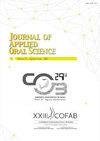治疗颞下颌肌筋膜性疼痛患者的手动疗法中加入电按摩的效果:随机对照试验。
IF 2.6
3区 医学
Q2 DENTISTRY, ORAL SURGERY & MEDICINE
引用次数: 0
摘要
目的评估在徒手疗法(MT)中加入动态颈椎电刺激(电按摩,ES)与徒手疗法本身相比,对颞下颌肌筋膜疼痛患者的影响。方法将患有双侧颞下颌肌筋膜疼痛至少三个月的 46 名参与者分为两组。第一组(21 人)接受局部 MT,包括颈部和颞下颌区域的软组织动员和松解技术。第二组(25 人)在颈部接受 ES 治疗,同时采取与第一组相同的干预措施。主要结果为疼痛强度(视觉模拟量表)、颌下肌和斜方肌上部的压痛阈值(PPT)(测压计)以及无痛垂直张口(手动量表)。次要结果是颈椎活动范围。结果方差分析显示,组别*时间的变化显著,第 2 组在疼痛强度(p< 0.001;η2>0.14)、压痛敏感度和张口度(p0.14)方面的结果更好(效应大小较大)。结论对于患有颞下颌肌筋膜性疼痛的受试者,颈部电刺激疗法结合颈部和颞下颌关节 MT 方案比 MT 本身具有更好的临床疗效。注册代码:NCT04098952:NCT04098952。本文章由计算机程序翻译,如有差异,请以英文原文为准。
Effects of adding electro-massage to manual therapy for the treatment of individuals with myofascial temporomandibular pain: a randomized controlled trial.
OBJECTIVE
To evaluate the effect of the addition of dynamic cervical electrical stimulation (electro-massage, ES) to manual therapy (MT), compared to MT by itself, in individuals with myofascial temporomandibular pain.
METHODOLOGY
A total of 46 participants with bilateral myofascial temporomandibular pain for at least three months were distributed into two groups. Group 1 (n=21) received local MT consisting of soft tissue mobilization and release techniques over the neck and temporomandibular regions. Group 2 (n=25) received an ES procedure in the cervical region combined with the same intervention as group 1. All participants underwent a 2-week protocol. The primary outcomes were pain intensity (Visual Analogue Scale), pressure pain threshold (PPT) at the masseter and upper trapezius muscles (algometer), and pain-free vertical mouth opening (manual gauge). The secondary outcome was active cervical range-of-movement. Measurements were taken at baseline, immediately after intervention, and at a 4-week follow-up.
RESULTS
The ANOVA revealed significant changes over group*time, with better results for group 2 (large effect sizes) regarding pain intensity (p< 0.001; η2>0.14), pressure pain sensitivity and mouth opening (p<0.001; η2>0.14). Similar findings were observed for active cervical range-of-movement in all directions (p<0.001; η2>0.14), except rotation (p≥0.05).
CONCLUSION
Electrical stimulation therapy over the cervical region combined with a MT protocol over the neck and temporomandibular joint shows better clinical benefits than MT by itself in subjects with myofascial temporomandibular pain. Registration code: NCT04098952.
求助全文
通过发布文献求助,成功后即可免费获取论文全文。
去求助
来源期刊

Journal of Applied Oral Science
医学-牙科与口腔外科
CiteScore
4.80
自引率
3.70%
发文量
46
审稿时长
4-8 weeks
期刊介绍:
The Journal of Applied Oral Science is committed in publishing the scientific and technologic advances achieved by the dental community, according to the quality indicators and peer reviewed material, with the objective of assuring its acceptability at the local, regional, national and international levels. The primary goal of The Journal of Applied Oral Science is to publish the outcomes of original investigations as well as invited case reports and invited reviews in the field of Dentistry and related areas.
 求助内容:
求助内容: 应助结果提醒方式:
应助结果提醒方式:


